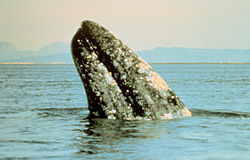 Below is the Stinky Whale story I posted in May of this year. I was hoping to update it with more information but it still seems to be a bit of a mystery. There was a National Geographic article in June, bringing the issue to a bigger audience but the cause of the problem, let alone the solution, still seems elusive. Gray Whales are the whales you will see from here as they migrate past each and every year. Gray whales migrate farther than any mammal - between their warm birthing lagoons in Mexico and their arctic feeding grounds. A 10,000 mile roundtrip every year of their lives. The journey north around February each year and is quite spread out so late Winter and early Spring is your best time for Whale watching. Last year the peak day for observations from Coal Oil Point was March 22nd when 41 Gray Whales were spotted. There is some information on the COP Gray Whale counts and a link for how to get involved with 2009 monitoring at this page.
Below is the Stinky Whale story I posted in May of this year. I was hoping to update it with more information but it still seems to be a bit of a mystery. There was a National Geographic article in June, bringing the issue to a bigger audience but the cause of the problem, let alone the solution, still seems elusive. Gray Whales are the whales you will see from here as they migrate past each and every year. Gray whales migrate farther than any mammal - between their warm birthing lagoons in Mexico and their arctic feeding grounds. A 10,000 mile roundtrip every year of their lives. The journey north around February each year and is quite spread out so late Winter and early Spring is your best time for Whale watching. Last year the peak day for observations from Coal Oil Point was March 22nd when 41 Gray Whales were spotted. There is some information on the COP Gray Whale counts and a link for how to get involved with 2009 monitoring at this page.Gray Whales have been granted protection from commercial hunting by the International Whaling Commission since 1949, and are no longer hunted on a large scale. Limited hunting of Gray Whales has continued since that time, however, primarily in the Chukotka region of north-eastern Russia, where large numbers of Gray Whales spend the summer months. This hunt has been allowed under an "aboriginal/subsistence whaling" exception to the commercial-hunting ban and the annual quota for the Gray Whale catch in the region is 140 whales per year. After increasing from the brink of extinction to a population of about 20,000 the grey whales now seem to be struggling. Numbers are estimated to have fallen to between 15,000 and 18,000, and some researchers are concerned that the trend of the past few decades may have reversed.
In the past few years, the aboriginal whalers of the eastern coastline who hunt gray whales for meat have reported that an increasing number of them smell so foul that even dogs won't eat them. The few people who have tried the meat suffered numb mouths, stomach ache and skin rashes.
Possible culprits are either pollutants in the ocean or a change in the whales diet. A preliminary analysis has not revealed any unexpected pollutants and attention has switched to diet. One possibility is that the smell is a side effect of following a cetacean version of the Atkins diet as their diet shifts. There is some evidence to support this idea: the whales normally stick to a diet of shrimp-like crustaceans called amphipods, but hunters have reported finding stinky whales' stomachs full of seaweed and cod. As with the Atkins diet in humans, this could be causing the whales to enter the state known as ketosis, in which they burn fat for energy. In people, this causes bad breath. Perhaps the whales are undergoing something similar.
No comments:
Post a Comment